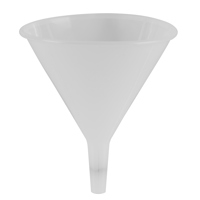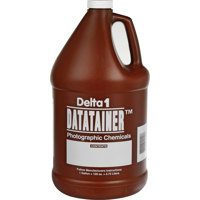
Overview
Compare
Accessories
Protection
Q&A
Questions & Answers
FAQ
What type of images does the Kodak DEKTOL Black & White Paper Developer produce?
The Kodak DEKTOL developer produces neutral and cold-tone images, ideal for achieving fine tones and contrast in black and white photography.
How much developer does one packet of Kodak DEKTOL powder make?
One packet of Kodak DEKTOL powder creates a full gallon of developer, providing ample supply for various photographic projects.
Is the Kodak DEKTOL developer suitable for tray processing?
Yes, the Kodak DEKTOL developer is particularly effective for tray processing, making it a popular choice among both high school photography programs and professional studios.
Who can benefit from using the Kodak DEKTOL Black & White Paper Developer?
Both amateur and professional photographers can benefit from using the Kodak DEKTOL developer due to its consistent results and high-quality image production.
What are the key benefits of using Kodak DEKTOL developer?
Key benefits include producing crisp whites and rich blacks, reliable consistency, and ease of preparation, making it a trusted choice for photographers seeking superior black and white prints.
Shopper : What is the shelf life of this developer once it is mixed?Also can anyone tell me how it compares to other developers,such as Sprint liquid concentrate?
ThanksROBERT B : I have been using Dektol for probably 50 years. The results are always good and reliable. I would suggest that in a brown, glass fully stoppered bottle, as full as possible, it should last for at least 6 months in stock solution form. I always dump used, working solutions at the end of a print making session.DAVID H : Best all around print developer, especially with MG papers. Sprint is ok on RC but no match on fiber. Shelf life is all environment, less air and cooler temps mean longer life. I've seen six months plus. Dissolves better at 110 degrees, works great at 1:3 dilution for extended tonal range and more mpg.PATRICK F : I have used it for up to six months with good result.
I think it's an excellent developer. I have not used the Sprint.MARY M : If the container is full, the shelf life is longer...I'd say a couple of months maybe. Longer if it is totally full. Don't know sprint but this is a really good developer and can use undiluted for more contrast.DAVID K : Against most common advice, I mix up a gallon of dektol, dilute it 1:2 immediately, and store it in three 1-gallon PETE bottlees. I don't usually get to the third gallon for at least a couple months, but the color remains unchanged and it seems to perform as good (with consistent Dmax) as the first gallon. I use factorial development and pour it back in the bottle between sessions. I discard the working solution after 60-80 8x10s although it still seems to have plenty of life left in it.JOSEPH P : Usually six months to a year.JOHN U : Once mixed, 1 gallon of Dektol should last between 1 and 2 months. Much depends on the volume of air in the storage container and the temperature its stored at. Working solutions will typically last about 24 hours in the tray and perhaps 3 to 5 days if the tray is covered with a good floating lid.
If have not had any specific experience with Sprint, but most concentrated liquid developers have a fairly long life of perhaps 6 to 12 months. Again, the volume of air in the container and the ambient temperature affects storage life. Once diluted, the working solution should last about as long as Dektol.BOBETTE G : It cannot be any longer than 60 days or it will start turning a dark brown and smell. I then know it has gone bad.
Shopper : Can the powder be mixed with tap water ?
Is distilled water necessary? Does it make a difference?
Thank you,
MartaJONATHAN D : Yes, I always use tap water.ACCOUNTS P : Yes, the powder can be mixed with tap water. I have been doing it for years and have gotten great results with the product. Just make sure you have the water at the correct temperature or it won't work as well. KEVIN O : Hey Marta,
I've actually used Dektol, along with D-76 and Fixer and have always used tap water and haven't really had a problem with them. I am not a professional, but do this as a hobby.
Hope this helps!PAUL W : I always use distilled water; it's only a buck but it takes one worry out of developing, here in SW Florida the tap water is treated with harsh chemicals.CHAUNCEY M : I have always used tap water and have had no problems.PATRICK F : Hi Marta.
I have never used distilled water and my photographs turn out just fine. The person who taught me also never used distilled water.
Glad to see there are still purists out there developing film! Good luck!
PatrickMARY M : tap water is fine! I've used it for 20 years and never tried distilled so don't know but it works great with tap.KENNETH O : I always use tap water - but it is VERY well filtered tap water. I have used plain tap water in the past - but the results will depend upon the quality of the water. The bottom line is the higher the quality of the water (less impurities) the more consistent the results. This, of course, assumes the temperature, dilution, developing times, agitation, washing, etc are all kept consistent also.ANTHONY W : I am an advanced amateur photographer and use tap water to mix my Kodak chemicals. I have never read that distilled water should be used, but I do use distilled water and 3-5 drops of photoflo solution as my final rinse while processing my negatives.KRISTOPHER B : I've used Dektol for many years and have never used anything but tap water and have never had any issues with it.LUCIAN S : I use it with Tap water all the time. You will not have a problem developing.
However, if your tapwater leaves spots when drying after final developing, you should use a clearing fluid and you might need to squeegee the film.DOUGLAS S : Yes you can. I do it all of the time. However, our water here, is some of the cleanest in the nation. I think you will be fine. If you can, try and reclaim the silver and other chemicals and dispose of all wastes properly. TONY S : Tap water is usually fine. I use it and have never had issues.ALBERT A : Tap water is fine.GARY S : I use tap water to mix Dektol and have not had any problems. I live in the NW so we don't have a lot of limestone (calcium) in the water. You might have different results depending on the water.GREGORY P : I mix it with tap water personally, and it is fine. I only use distilled water for washing negatives.
Shopper : Why Did You Choose This?JAMES DRAPER J : I have used Dektol since my first darkroom class and have found it to be very reliable.harri s : develop b&w printsBRIAN R : my paper developer of choiceTOM W : Works best for developing the film I exclusively use for my photo work.Chris T : Basic Darkroom SuppliesArchie P : Quality chemical for developing B&W photos.Mike D : Been using it over 50 years now. LOLEliza R : making an at home dark roomPatrick G : A classic paper developer that works well for cold and neutral tones.
Reviews about this item
Review Summary
2019-05-29T12:15:28
Rated 5 out of 5
Dektol Paper Developer
Dektol is a fine developer and gives very consistent results. Even Ansel Adams and other greats used it extensively. It gives fairly cold tones and good blacks. Dilute 1:3 and develop for at least 2 min or even 3. Make sure to give print thorough agitation in the tray by flipping and agitating….NOT just rocking the tray.
RAY G.
2018-07-04T12:30:50
Rated 5 out of 5
Good old Dektol!
I stopped using Dektol for a few years. The ease of using Ilford’s liquid concentrate appealed to me. However, when I ordered a bag of Dektol, I remembered how much I like it. It’s inexpensive and seems to last longer than the Ilford developer.
MATT H.
2018-05-30T08:38:01
Rated 3 out of 5
Good results, but the prep is a pain
My prints look good, but I don't really like having to prep a full gallon when I don't make very many prints. The shelf life isn't great, so I'm not sure I'll use it up before it goes bad. Also, my darkroom is pretty cold, and the stock solution crystalizes in the bottle. Doesn't seem to effect anything, though. I'll probably try a concentrated liquid paper developer next time.
Russ L.
2018-03-13T09:55:53
Rated 5 out of 5
Always have good luck with this.
Dektol has always been my go-to developer. Every now and then I'll try branching out, but I always end up coming back. for the consistency.
Dale A.
2017-08-23T12:24:32
Rated 5 out of 5
B&W Chems
the best paper developer
David W.
2017-01-25T13:25:48
Rated 5 out of 5
Standard Chemicals - Available Quickly
I needed standard chemicals for film and paper developing. My previous supplier could not ship the film developer so I went to Adorama Camera which had it to me in two days. I have used these chemicals for more than 40 years and like the consistent results I get.
Phil B.
2016-08-24T18:17:36
Rated 5 out of 5
Great Stuff!
Always been a great print developer, and still is!
DAVID F.
2016-04-19T17:44:42
Rated 5 out of 5
Love the dektol
For photo paper I like the dektol. It makes a stock and then the developer mixture.
TAHOE D.
2014-08-18T21:00:00
Rated 5 out of 5
A classic paper developer
I really like Dektol because it works very well. I have a darkroom in my garage, and I use trays to print B&W. It lasts for a long time, and has plenty of capacity. Prints come out neutral toned. Finished prints respond well to selenium and sepia toning. Sepia toning comes out quite warm, while selenium is cool to cold depending on how long in toner. Dektol is economical to use. I have left it in the tray for almost a week and it still worked. It was brown and nasty looking, like coffee, however it worked. The stock solution keeps well, mine is 9 months old and is good. I would recommend Dektol to anyone who is looking for an easy to use, standard paper developer.
CHARLES T.
2014-08-04T21:00:00
Rated 5 out of 5
Classic Paper developer that works great
Dektol is the classic paper developer from Kodak. It is easy to mix and use and has a long life in the tray. Shelf life of the stock solution is good too. I really like this developer. I would recommend using distilled water to make the stock solution, I feel it helps it keep longer. I have used it after sitting in the tray for almost a week and it worked well. It was fairly dark from oxidation but had plenty of power left. Dektol is great for most printing work. I used to use liquid paper developer, but I found it went bad faster. I would recommend this to all silver halide artists.
CHARLES T.
2014-07-04T21:00:00
Rated 5 out of 5
Heads up--also works as a FILM developer
Back in the late 70's our HS photo dept was on a tight budget...the instructor had a neat old trick where you dilute the dektol 23:1 for a "one shot" (single use) film developer. So a gallon mix of paper developer turns into 23 gallons of film developer. As I recall we used HC110 Dilution B times & temps and got very nice results--368 rolls from a gallon is a neat trick
DANIEL K.
2013-02-04T19:00:00
Rated 5 out of 5
Kodak Dektol Paper Developer
For development of all types of, fiber and RC, black and white papers. I have always gotten excellent results when using this developer as directed. No complaints here. As long as Kodak continues to manufacture Dektol, I will continue to purchase it.
JEFFREY M.
2013-01-06T19:00:00
Rated 5 out of 5
Very Good Product and affordable
I use this product with my first year high school photography students and they always obtain positive results.
Woodworker
2012-12-12T19:00:00
Rated 5 out of 5
Dektol
Next to Amidol, this is far the best. It has been a industry standard longer than I have been using a cold tone developer. Considering I started using this in high school (1971). I knew Brett Weston and when he view my images, he really liked the nice contrast. A nice crisp white to rich black.
baron
2010-08-22T21:00:00
Rated 4 out of 5
Classic Developer
Dektol always comes through with small grain, fine tones and contrast. Great for my pinhole cameras.
Greg P.
2010-01-24T19:00:00
Rated 4 out of 5
good stuff
easy to mix and use
TARA B.
3 Accessories for Kodak Dektol Black & White Paper Developer, Powder to Make 1 Gallon.
- All Accessories (3)
- Darkroom Aids (3)

Adorama Chemical Stirring, Plastic Mixing Paddles
$7.95
Recommended
Adorama 17 ounce Plastic Funnel (500 ml) with fine filter
$10.95
Recommended
Chem Seal Chem-Seal Delta 1 One Gallon Plastic Chemical Storage Container
$11.95
RecommendedAbout Kodak 1464726 Dektol Black/White Paper Developer
FEATURED REVIEWS
Dektol Paper Developer
By RAY G.
Dektol is a fine developer and gives very consistent results. Even Ansel Adams and other greats used it extensively. It gives fairly cold tones and good blacks. Dilute 1:3 and develop for at least 2 min or even 3. Make sure to give print thorough agitation in the tray by flipping and agitating….NOT just rocking the tray.
Good old Dektol!
By MATT H.
I stopped using Dektol for a few years. The ease of using Ilford’s liquid concentrate appealed to me. However, when I ordered a bag of Dektol, I remembered how much I like it. It’s inexpensive and seems to last longer than the Ilford developer.
For photographers seeking exceptional quality in black and white prints, the Kodak DEKTOL Black & White Paper Developer is an indispensable choice. This premium powder developer is formulated to deliver neutral and cold-tone images, making it ideal for both budding photographers and seasoned professionals. Known for its high capacity and consistent development rate, the DEKTOL developer ensures uniform results, enhancing the fine tones and contrast that photographers strive for. Its effectiveness in tray processing makes it a preferred option for high school photography programs and professional studios alike. Whether you're using a pinhole camera or exploring various photographic techniques, this developer consistently produces crisp whites and rich blacks, as praised by users who have relied on it for decades. Easy to mix, a single packet of powder yields a full gallon of developer, providing ample supply for your creative projects. Trust in the enduring quality of Kodak's DEKTOL Black & White Paper Developer, a staple in the photographic community for those who demand superior results in their black and white imagery.
Kodak 1464726 Dektol Black/White Paper Developer Features
- High-quality, single-powder black & white paper developer from Kodak
- Designed to produce neutral and cold-tone images
- High capacity and uniform development rate for consistent results
- Ideal for tray processing, suitable for both amateur and professional photographers
- Easy to prepare, transforms into a full gallon of developer from a single packet
- Reliable choice for capturing fine tones and contrast in black and white photography
Key Features
- Premium powder developer for black and white photography
- Produces neutral and cold-tone images with high consistency
- Ideal for tray processing in educational and professional settings
- Delivers crisp whites and rich blacks for superior image contrast
- Easy to mix, creating 1 gallon of developer from a single packet
- Trusted by photographers for reliable and high-quality results